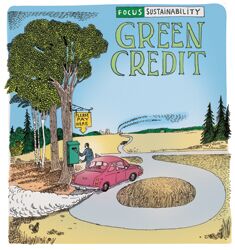Green credit | A roadmap to assess where, when and why carbon credits might make sense for you
 Illustration/Pat Corrigan
Illustration/Pat Corrigan
Feeling a tad guilty about switching on the A/C in the office? Wondering if there’s a way to mitigate the environmental damage of your employees’ commutes? Or just curious about a market where the commodity is literally made of air? Welcome to the beguiling world of carbon offsets, where your polluting ways can be absolved — or at least tempered — by investing in businesses and practices that work to restore a healthy planet by keeping greenhouse gases out of the atmosphere.
Since 2008, a novel multi-state climate agreement has been grabbing all the headlines. Power plants in 10 Northeast and mid-Atlantic states have been mandated through the Regional Greenhouse Gas Initiative to buy allowances to make up for their emissions. RGGI, as it’s known, is the first cap-and-trade program in the United States, and has generated more than $23 million for energy-efficiency programs and renewable energy in Maine. Lately the initiative has run into a few bumps, including New Jersey’s recently announced pullout by the end of the year.
All the while, a much smaller secondary carbon market has been quietly headed our way — the voluntary market for carbon offsets. In the United States, which famously did not sign the Kyoto Protocol and killed a federal climate-change bill last year, this market is purely optional, yet growing. Experts say up to last year, much of its growth came from U.S. companies anticipating broader greenhouse-gas curbing rules.
“What drove the voluntary market was the expectation that there would be compliancy regulations across the economic sectors,” says Catherine Lee, an emissions-trading expert and founder of Lee International in Westbrook. So what is fueling the market? “It’s much more recent, this idea of, ‘I’ll do this voluntarily because my customers will like it.’ That’s what’s driving it now,” Lee says.
Signs of that activity are sprouting in Maine: a new Lakes-area initiative will plant trees for carbon credits this year; Idexx Laboratories Inc. in Westbrook indicates it’s ready to jump into the market soon; and automaker Chevrolet last winter contracted with MaineHousing to buy carbon offsets produced from the weatherization of low-income homes.
The carbon market is “not for the faint hearted,” Lee warns, so here is a guide to help you decide if carbon offsets are worth the investment.
What is the voluntary market?
The voluntary market for carbon offsets is like the little sister of compliance markets such as RGGI. It works like this: if you emit a metric ton of carbon, you pay someone else to save a ton of carbon. Voluntary carbon transactions are driven by corporations with social-responsibility agendas, and by buyers who purchase cheap credits today in the eventuality of mandatory cap-and-trade systems later. All carbon trading is an attempt to slow climate change, which scientists say is primarily caused by carbon dioxide released from burning fossil fuels that heats the Earth’s atmosphere and leads to rising sea levels, longer droughts, floods and melting glaciers.
The voluntary carbon market is a sliver of the $124 billion regulated worldwide market. It’s only .02% of the total volume and less than .01% of the value, according to the 2011 State of the Voluntary Carbon Markets, an annual report by Ecosystem Marketplace and Bloomberg New Energy Finance.
But creditable organizations over the past few years have developed stringent standards for selling offsets that are solid enough to draw in new sellers and buyers. The carbon-market report finds the volume of greenhouse gasses traded in the voluntary market grew 34% between 2009 and 2010, to 131.2 million metric tons — almost double 2007 levels. The total value of the market was at least $424 million in 2010, the report finds, slightly greater than 2009 but only about half the size of the market at its height in 2008.
Since there’s no regulation of the voluntary market, it’s hard to keep track of who is selling and buying offsets. For certain, there are hundreds of projects selling credits all over the world. These run the gamut, from tree planting and methane capture at landfills (methane is over 20 times more damaging than CO2) to the College of the Atlantic’s purchase of offsets from a truck-stop project that supplies electricity to trucks so drivers can stop idling engines and still stay warm.
Finding a local source selling carbon offsets (MaineHousing can only sell to Chevy over its five-year contract) is nearly impossible, but that will change when Manomet Center for Conservation Sciences, an environmental nonprofit in Brunswick, launches a buy-local carbon project in July (see “The Clean Water Carbon Fund,“ below).
As for the future of the voluntary market, carbon suppliers anticipate continued growth, especially if a network emerges “of compliance-based or semi-compliant regional markets that draw on the rapidly maturing voluntary carbon markets,” the report states. They are expecting that when California launches its cap-and-trade system, the first such statewide program in the country, on Jan 1., carbon offset prices will spike and there might not be enough supply to meed demand. But that program has run into political snags, and the lack of any near-term federal cap-and-trade regulation could take its toll, Lee notes. “I don’t think we’ll see the expansion we saw when [the voluntary market] was doubling every year,” she says. “We’re not seeing that growth because compliance isn’t around the corner.”
How do I buy?
If a company wants to buy carbon offsets, it must first calculate its carbon footprint, which is the amount of greenhouse gasses sent into the atmosphere every year. There are easy-to-use online calculators that count emissions, letting you tally everything from air miles traveled to utility bills. Or businesses can hire a consultant to do an energy audit, says Merritt Carey, the manager of Maine Businesses for Sustainability and founder of the Portland marketing firm GraffamSolutions. Before buying offsets, most companies reduce their emissions by turning off lights, adding insulation, buying solar panels and installing showers for employees who bike to work, etc. Buying carbon offsets is often the final step in an overall green strategy.
The next step is choosing which project to support. Most worthwhile projects sign on to a carbon registry, such as the Climate Action Reserve, Voluntary Carbon Standard or the American Carbon Registry. “This is a way for the business and the consumer to know it is a legitimate project,” Carey says. “If you’re trying to incorporate a longtime plan in offsets, you don’t want to invest in a project that’s not doing the right thing.” These registries guarantee projects adhere to protocols that ensure, for example, a carbon supplier isn’t selling a credit twice. All registered projects must be monitored and verified by third-party contractors.
Businesses can choose to buy carbon credits from a retailer, or go right to the source. Do you want to plant trees to sequester carbon? Help low-income people stay warm? Finance wind turbines? Clean landfills? It depends on what you’re after.
“Tree planting and the weatherization of low-income housing, these have high marketing value,” says Margie Gardner, CEO of Bonneville Environmental Foundation in Portland, Ore. “In terms of carbon, they’re a small piece, but an important piece. Pretty much all buyers prefer real, verifiable offsets that have an environmental impact and a great story. If it can be sourced locally, they love it. If it also has a societal benefit, you have a real winner.”
Gardner’s organization helped broker the carbon-offset deal between MaineHousing and Chevrolet (see “Who’s trading CO2 in Maine?” below). Bill Devine, a marketing manager with Chevy, says the Maine project is just one of many U.S. carbon-reduction programs his company will invest in over the next five years as a non-traditional marketing strategy. “It’s a pretty bold step,” Devine says, “but we hope consumers will view us differently, and they will, because this is the right thing to do.”
How do I sell?
Sellers first must qualify as eligible market participants. Carbon registries like Climate Action Reserve have developed criteria for a number of different project types, including reforestation efforts, manure bio-gas controls at farms and landfill gas-destruction systems. Almost anyone can sell a carbon credit if it saves a ton of carbon, Lee says, as long as it is certified.
The costs of registering, verifying and monitoring a project can run into the thousands of dollars. Because carbon-offset prices are cheap these days — on average from $3 to $15 per ton, according to the Bonneville Environmental Foundation — the high upfront costs can be a disincentive.
Mark Berry, executive director of the Downeast Lakes Land Trust in Washington County, says his trust is considering selling carbon credits to improve its forest management. But Berry says the long-term commitment, financial investment and today’s lousy market conditions will factor into the trust’s decision. “What we don’t know is how robust [a carbon] market will be relative to what we know would be the long-term costs for verification and monitoring,” Berry says. “We won’t enter into this if it would be a long-term financial drain.”
Landfills in Presque Isle and Fort Fairfield are also certifying their emission-reduction projects, with the hope of sales before the year’s end. Dana Fowler, Presque Isle’s solid waste manager, says, “We’re hoping to receive revenue to decrease the tax burden to the taxpayers of Presque Isle.”
Mark Draper, solid waste director in Fort Fairfield, says verification of his methane-reduction program has cost about $10,000, not including the cost of new monitors. The landfill has already contracted to sell a year’s worth of credits to retailer TerraPass at $5 a ton, for an anticipated $12,000. Then the landfill will need another buyer. “The market right now is terrible, so if you look at the cost of third-party certification and everything else, we’ll lose money until the market turns around,” Draper says.
Should I do it?
It’s easy to shy away from an investment that you can’t see, touch or hold. The College of the Atlantic has bought carbon offsets for the past four years. But interim President Andy Griffiths says the academic community has begun questioning whether it should put its money elsewhere, such as in a student project to develop butanol, an alternative fuel, from food waste.
Maine Interfaith Power and Light, a nonprofit electricity aggregator, sold carbon offsets between 2004 and 2010. But former director Harry Brown says they never caught on. “It is a really tough sell,” he says. “If you sit down with Uncle Bob at Christmas and try to explain this, Uncle Bob will just give you a long blank stare.”
Yet Brown also acknowledges their value to those who understand them. “Businesses are looking for ways to green up their profile and donate their money in some ways, and if they know they can claim they’re carbon neutral by making this purchase, it’s a feather in their cap,” he says.
Rebecca Goldfine, Mainebiz staff writer, can be reached at rgoldfine@mainebiz.biz.









Comments